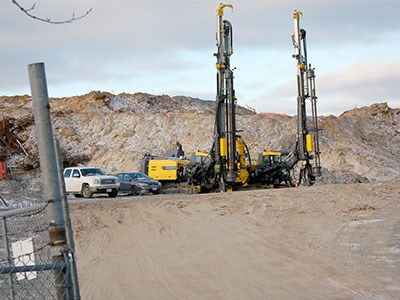The process to operate an open pit mine adjacent to Timmins' downtown core has been a long and difficult one.
Goldcorp's Hollinger project involves a 250-acre fenced property housing the former Hollinger Mine, which was shuttered in the late 1960s. It is expected to begin operations this winter.
Its underground workings have created sinkholes and subsidences in the area and millions of dollars have been spent filling them. Creating an open pit operation will remove the underground hazards and the land will be useable once a closure plan is complete.
The company received city council's unanimous approval late last fall, along with the support of the Hollinger Project Community Advisory Committee (HPCAC).
“We can't kid ourselves, any project like this is hard,” said Marc Lauzier, Porcupine Gold Mines general manager. “The public process was a difficult one, and we learned a lot throughout that process.”
For the past five years, Goldcorp has been advising the community of its plans for the Hollinger Project through open houses and other activities. A community liaison co-ordinator was hired to deal with feedback, and a Hollinger Information Centre was opened. The co-ordinator and office will remain for the duration of the eight-year project.
“The biggest challenge for us – and I have lived this in other communities – is that you call public meetings and a few people show up. It’s hard to get good honest feedback up front because people are busy,” he said. “When you get close to the mining activity, things heat up and people care and show up. The feedback you get in the last three weeks is the feedback you probably wanted three years ago.”
Timmins also has an acceptance of mining in the community, which makes it a good place to do it, but which also makes it more difficult to get constructive feedback at times.
Feedback has been given by the advisory committee, which is headed by Rick Dubeau of Schumacher.
“I got involved in the committee because all kinds of rumours were going around, including that Schumacher was going to be a big hole. I want to protect my quality of life here,” he said.
The group supported the open pit project and it didn’t want to stop the company from moving ahead on it. But, there are some lingering concerns and questions the members feel still need to be addressed.
One of them is that not all the best practices from similar projects close to residential areas are being utilized by Goldcorp.
Dubeau said in Malartic, Que., where Osisko Mining Corp. is operating an open pit gold project, the company moved or bought all homes from within 300 metres of the pit. Rubber tracks were installed on the heavy equipment to minimize noise and drills were converted from pulsating to rotary.
“We feel that some of these practices should be instituted,” he said. “Some homes will only be 150 metres from the pit.”
The 150-metre setback was approved by city council in a bylaw allowing a mine to reactivate an historical site as long as certain conditions were met.
“The ministry (of the environment) guidelines say a mine should not be within 300 metres of any residential or business areas,” Dubeau said.
Goldcorp said the Hollinger Project is often compared to Osisko’s pit in Malartic, but the mine manager said it is unfair.
“Osisko’s is a larger scale pit than ours and much more profitable since they are taking big deposits. Our pit isn’t being mined in the most productive manner, but in a way that mitigates risks to the community. Because of that, we are slowing down the mining rates and are drilling smaller holes and doing smaller blasts. Our primary goal is to reclaim the land,” Lauzier said.
Instrumentation for noise and vibration have been installed and the results will be available publicly on a website.
“If there is a warning or an exceedance that is triggered, it alerts our staff and they can actually go and listen to the clip and determine what the noise was, and if necessary, begin an investigation,” said Paul Miller, operations superintendent at Goldcorp.
Blast warning signs have been erected in some areas that will inform the public of when to expect them.
“There are two prescribed blasts a day, which may not happen. It’s the only time we can blast and they will occur during the day shift. We can’t just blast at will,” he said.
A voluntary pre-blast inspection was done on homes, businesses and city infrastructure located 300 metres from the pit. In the event damage is claimed from the operations, a third-party engineer will determine the cause. If it is from the company’s activities, it will compensate for the damage or do repairs.
A berm will be constructed around the perimeter of the property, and two haul roads have been built to truck the ore to the South Porcupine mill. It will employee a total of 180 people.
The final plans for what will remain for public use from the open pit project have not been finalized.
There will be a lake that will take several years after the operations to fill up.
“There are a lot of open holes and glory holes now. We will try to reclaim as much as we can since it has to be safe for our employees and the public. We will return whatever we can for public use afterwards but there will be much more land than there is now,” Lauzier said.




